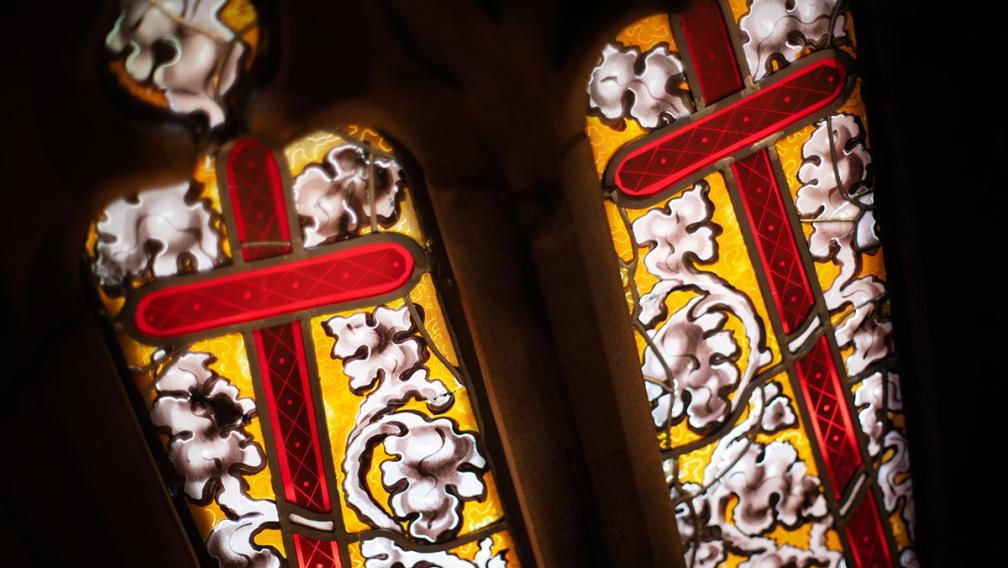What does the cross mean to you?

In Sunday’s Gospel, we see Mark’s account of the first passion prediction: Jesus reveals his plan to die in Jerusalem.
It is a lesson in which Jesus begins to teach his followers that he will suffer, be killed, and rise again. When Peter protests, Jesus pulls him aside and scolds him harshly saying, “Get behind me, Satan.” Jesus continues with clear instructions to the disciples and the people gathered about the nature of discipleship: “If any want to become my followers, let them deny themselves and take up their cross and follow me.” These are hard words.
If any want to become my followers, let them deny themselves and take up their cross and follow me.
Mark 8:34
At the time of Jesus, Roman crosses at the roadside were a common gruesome sight. His message was clear to all who heard: Taking up your cross is no choice for comfortable observers; discipleship, he said, includes the possibility of really suffering and dying. The choice was theirs and acceptance would have consequences that require faith and courage. As Dietrich Bonhoeffer wrote in The Cost of Discipleship, “When Jesus bids [one] come, he bids [one] come and die.”
What does it mean to take up my cross? What does Jesus’ cross have to do with my life today?
My dear mother-in-law will often remind and encourage us with these words: “Take up your cross, daily.” Typical of me, I’d prefer to jump over into resurrection joy and skip over the cross part. But as I mature spiritually, I find myself less and less resistant to the idea of taking up my cross. These days, I take it to mean that I can choose to move along in trust and with patience through all that my life offers — the difficulties and the joys and everything in between.
These days, I understand my cross as my attachment to either the joys or the sorrows; I have the power to choose to exchange my grasping at joy or pushing at difficulties for a simpler, more easeful trust in God in the present moment. I can live in my truth without running away from the cross, as I am learning what it means to die to self. As I practice compassion for myself and for others who are also walking this human path, I hope to learn something about the mystery of a love that suffers, the strength in vulnerability that Jesus embodied.
What does the cross mean to you?
Faithfully,
Kathy Bozzuti-Jones, PhD
Associate Director, Faith Formation & Education
Children’s Time
Sundays at 10am
Join us for Children’s Time on Zoom. We’ll start with a brief opening assembly together and then, each week, children can choose from two different breakout groups.
Godly Play (Preschool and older)
Story: The Faces of Easter 2
Response Time: Drawing and collage materials
Whole People of God (2nd Grade and older)
Lesson Theme: Which Way? Choices, Choices
Activities: Lenten Road Map, plain paper or roll of paper, if you have it, and writing/drawing implements
Register to join on Zoom, if you haven’t already.
Discovery
Psalm for the Wilderness
Sundays at 10am
The Season of Lent leads us through changing, and sometimes challenging, spiritual landscapes. Through the close examination of several beautiful and beloved examples, this Bible study will consider how the superlative Hebrew poetry of the Psalms might accompany us and enrich our journeys. For the first four Sundays of Lent, join Mother Beth Blunt and Summerlee Staten, Executive Director of Faith Formation & Education, in exploring the nature, history, and import of this pivotal collection. During the last week, parishioner and poet Chester Johnson will discuss his work on the drafting committee for the retranslation of the Psalms contained in the current Book of Common Prayer.
Learn more and register to join.
Spiritual Resources
- Whether for tactile learners, fidgety folks, or ritualized rhythms, prayer beads have aided people in their contemplative meditations, reflections, and focus since time immemorial. There are prescribed patterns and words for praying with beads. Some are complex and some are simple; or you can make yours as personal as your prayers.
- When suffering comes, as it inevitably will (or has), what would it be like to “be granted the wisdom to avoid false resistance”? John O’Donohue offers a blessing for times when the thing we feel least is blessed.
- Richard Rohr says, “We must all carry the cross of our own reality until God transforms us through it. These are the wounded healers of the world, and healers who have fully faced their wounds are the only ones who heal anyone else.”
- The cross is not too heavy for children either — when the weight doesn’t accumulate. Trinity’s children and families are practicing lament with the Psalms this Lent. If you would like a digital copy of the materials, please email Kathryn Carroll.
- Family Worship: Home Edition





